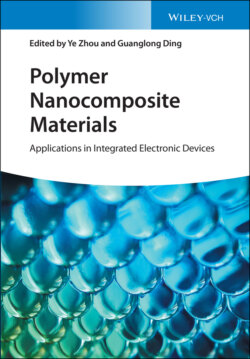Читать книгу Polymer Nanocomposite Materials - Группа авторов - Страница 34
2.2.3 In Situ Polymerization
ОглавлениеIn situ polymerization was firstly proposed by Imai et al. where polyimide (PI)/CB composite was obtained by dispersing the CB into the polymer salt monomer [66]. In fact, this is a unique solution based processing technology for preparing the CPCs, and chemical reaction is usually involved during the polymerization [67, 68]. The efficient polymer-chain graft onto the filler surface could form a perfect interface interaction between the filler and polymer matrices, which also improves the homogeneous dispersion of the fillers in the polymer matrix and influences the crystallization of polymer chains to some extent [69–71]. As a result, CPCs with a high weight content of the nanofillers can be obtained by this method [69, 72].
Zhu and coworkers prepared reduced graphene oxide (r-GO)/PI composites with different loadings of GO by in situ polymerization and the maximum content of GO can reach 30 wt%. During polymerization, a relatively high temperature was set to reduce GO into conductive r-GO in the polymer matrix. The electrical property of the obtained r-GO/PI was greatly enhanced, because of the conductive network formed by r-GO in the composite film and the conductivity could reach as high as 1.1 × 101 S m−1, which is about 1014 times that of pure PI film [73]. The mechanical properties of GO/PMMA composites fabricated by in situ polymerization were also tested by Potts et al. [74]. It is found that the elastic modulus and tensile strength of the GO/PMMA composites could be improved even with 1 wt% loading of fillers.
